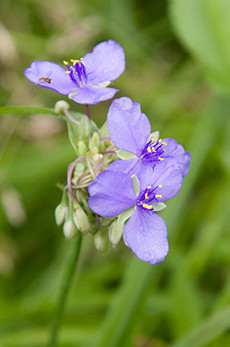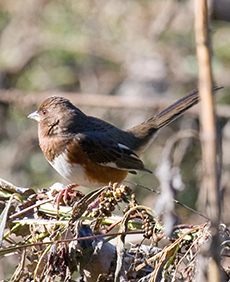Woodland Restoration

At the Litzsinger Road Ecology Center (LREC), we are in the process of restoring approximately 14 acres of degraded mesic to wet-mesic bottomland woodland. Mesic bottomland woodlands occur along the level or gradually sloping ground of stream or river floodplains and they have moderately well drained soils that are wet for part of the year, while wet-mesic bottomland woodlands often have some ponding. LREC has a mixture of these systems.
Vegetation in these systems is adapted to occasional flooding and fire and has an open structure with few understory species and 50–80% canopy cover. Characteristic trees include: hackberry, white oak, bur oak, shellbark hickory, swamp white oak, persimmon, cottonwood, pecan, and pin oak. Characteristic ground layer species include: black snakeroot, wood reed grass, poison ivy, wood nettle, giant cane, bluebells, white trout lily, pale violet, spiderwort, white anemone, sedges, and false rue anemone.
If you know your plants well, you’ll realize that many of these species are currently present at LREC; however, they are not dominant in our woodland habitats. Our dominant tree species are box elder, buckeye, elm, and sycamore. The dominant ground layer species are wintercreeper and wood nettle. While the woodland at LREC was never plowed (unlike our prairie), many other problems are present: invasive exotic species have become dominant species in the herbaceous layer, the hydrology has been altered by urban development, the area has been logged, and fire has been suppressed. Because of these changes, many of the tree species which would have been formerly dominant have been lost to logging and fire suppression, and the characteristic native ground layer species are found in low abundance due to exotic species invasion, flash flooding, and fire suppression.
To restore the native ground layer, we are controlling the wintercreeper by cutting climbing vines and painting the stumps with herbicide, spraying foliar herbicide on plants growing along the ground, and pulling it up where it is found in small, isolated areas. An experiment conducted at LREC and Ruth Park Woods in University City, Missouri showed that the best time to spray wintercreeper with foliar herbicide is in the early fall. Each year since 2008, we have sprayed wintercreeper in part of our woodland in the early fall. We follow the fall spraying with the seed sowing of native woodland species in these areas. As weather conditions and fuel loads allow, we try to burn patches of the woodland to clear the leaf litter and help control the invasive species. We are also planting trees that are adapted to mesic to wet-mesic woodlands in the woodland and along the creek banks. Through active management efforts, we hope that these trees will one day become the dominant canopy species.
A 2004 survey of 87 plots in the woodland showed that, of the 45 ground layer plant species found, 78% were native plant species. However, wintercreeper was present in 84% of the plots and, on average, covered from a quarter to a half of the area in the these plots. The next most common species, both natives, were wood nettle (found in 47% of the plots) and Virginia wild rye (found in 28% of the plots). Other native species were much less common. Over time, the restoration projects we are conducting should have a positive impact on the composition of this area.

In 2009–10, a survey of 78 woodland plots showed that, of the 68 species of ground layer plants identified, 82% were native. This is an increase in the number of species and the proportion of those species that are native when compared to the 2004 study. Wintercreeper was present in 91% of the plots, but the cover of this species within the plots has decreased substantially, generally accounting for less than a quarter of the plot area. Other common species in 2009–10 were wood nettle (found in 50% of the plots), Virginia wild rye (found in 28% of the plots), wingstem (found in 24% of the plots), and annual bedstraw (found in 24% of the plots).
LREC also hosts a diverse fauna. We have recorded 98 species of birds in the prairie and woodland, 18 species of mammals, 10 species of amphibians, and 23 species of reptiles (see our site inventories in our Research Studies for complete lists).